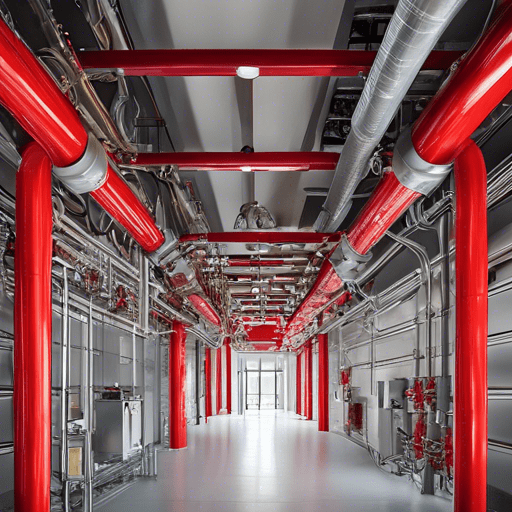In the picturesque landscapes of California, where sustainability is more than just a buzzword, the integration of green building practices

In high-rise buildings, fire safety is of utmost importance. The task of designing effective fire protection systems, including fire suppression and evacuation plans, can be incredibly complex. The challenge lies in ensuring that tall structures have the necessary measures in place to handle potential fires. Additionally, providing adequate water supply for firefighting purposes adds another layer of complexity to the design process.
Experienced and knowledgeable professionals are required to create MEP (Mechanical, Electrical, and Plumbing) fire protection systems that can effectively handle emergencies and protect the lives and property within these buildings. By carefully considering factors such as building codes, regulations, and fire safety standards, architects and engineers can ensure that the MEP systems are designed to meet the unique requirements of each high-rise structure. This article explores the intricacies and challenges involved in designing efficient and reliable MEP fire protection systems for tall buildings, emphasizing the crucial role they play in safeguarding lives and property.
High-rise buildings present unique challenges when it comes to fire safety. With multiple floors and a large number of occupants, the potential for a fire to spread quickly and cause significant damage is high. Therefore, it is crucial to prioritize fire safety in the design and construction of these structures. Implementing effective fire protection systems can help prevent the loss of life and property in the event of a fire.
MEP fire protection systems encompass a range of measures designed to detect, control, and suppress fires. These systems include fire alarms, sprinkler systems, smoke detectors, fire extinguishers, and emergency lighting. Each component plays a vital role in alerting occupants, containing the fire, and facilitating safe evacuation.
Designing fire suppression systems for high-rise buildings requires careful consideration of various factors. One key consideration is the height of the building, as it affects the water pressure needed to effectively suppress fires on higher floors. Additionally, the design must account for potential obstacles, such as stairwells and elevator shafts, that may hinder the flow of water and firefighters’ access to the affected areas.
In the event of a fire, a well-designed evacuation plan is crucial for ensuring the safe and orderly evacuation of occupants. High-rise buildings often have multiple exit routes, including staircases, elevators, and fire escape systems. These routes must be clearly marked, easily accessible, and regularly maintained to ensure their functionality during emergencies.
Having an adequate water supply for firefighting purposes is essential in tall structures. Firefighters rely on a sufficient water source to effectively suppress fires and prevent them from spreading. Designing systems that can deliver the required water pressure and volume to higher floors is a critical aspect of MEP fire protection system design.
Designing fire protection systems for high-rise buildings comes with its fair share of challenges. Limited space for equipment installation, complex building layouts, and the need to integrate fire safety measures with other building systems are some of the common challenges faced by architects and engineers. Overcoming these challenges requires innovative solutions and a deep understanding of fire safety principles.
To ensure the effectiveness of MEP fire protection systems in high-rise buildings, several best practices should be followed. These include conducting thorough fire risk assessments, using advanced fire detection technologies, implementing redundant systems for increased reliability, and regularly testing and maintaining the systems to ensure their proper functioning. By adhering to these best practices, architects and engineers can enhance the overall fire safety of tall structures.
Numerous high-rise buildings around the world have successfully implemented effective fire safety measures. Case studies of these buildings provide valuable insights into the design, implementation, and performance of MEP fire protection systems. By analyzing these case studies, architects and engineers can learn from successful examples and apply the lessons to their own projects.
Fire safety in high-rise buildings is governed by a set of regulations and codes that outline the minimum requirements for fire protection systems. These regulations vary from country to country and may include specifications for fire alarm systems, sprinkler systems, fire-resistant materials, and emergency evacuation procedures. Architects and engineers must stay updated with the latest codes and regulations to ensure compliance and the highest level of fire safety.
Designing effective MEP fire protection systems is critical in high-rise buildings to mitigate the risks associated with fires. By considering the unique challenges posed by tall structures and adhering to best practices and regulations, architects and engineers can create robust fire safety systems that protect lives and property. Fire safety should always be a top priority in the design and construction of high-rise buildings to ensure the well-being of occupants and the surrounding community.
About Author
Xhuljo Jakup